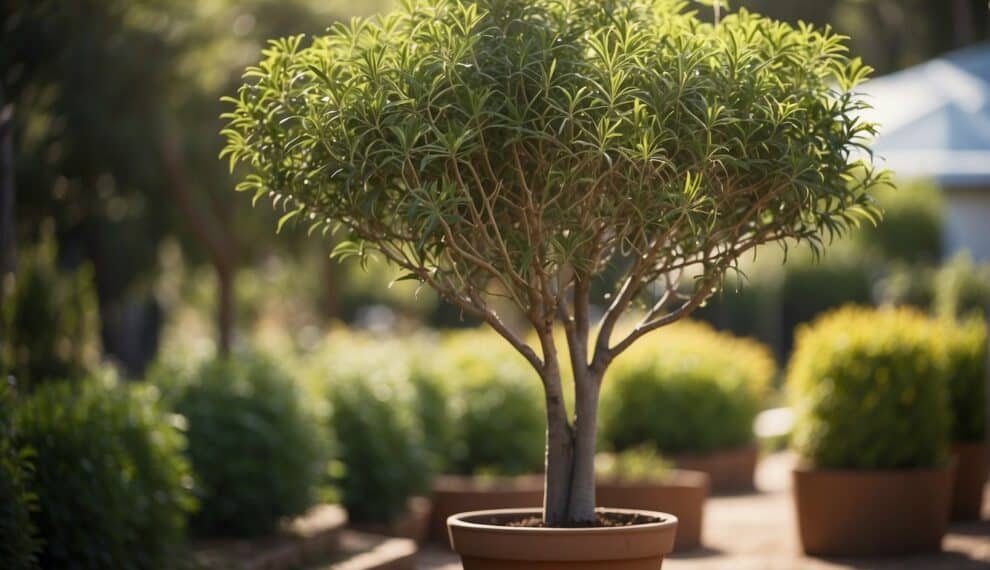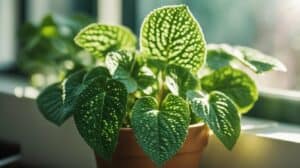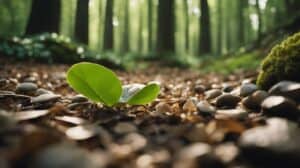Brachychiton Rupestris, commonly known as the Bottle Tree, is a unique and fascinating tree species that is native to Australia.
The tree’s distinctive appearance and unusual name come from its swollen trunk, which resembles a bottle.
This species of tree is highly valued for its ornamental qualities and its ability to adapt to a wide range of climatic conditions.
The Bottle Tree is a deciduous tree that can grow up to 30 feet tall and 20 feet wide.
Its trunk can reach a diameter of up to 10 feet, and it is covered with a thick, cork-like bark that is fire-resistant.
The tree’s leaves are large and leathery, and they turn yellow before falling off in the autumn.
The Bottle Tree produces showy, bell-shaped flowers that are usually red or yellow and bloom in the spring and summer.
These flowers are followed by woody, pear-shaped fruit that contain seeds.
Origins and Habitat

Brachychiton Rupestris, commonly known as the Bottle Tree, is a unique and fascinating tree species that is native to Australia.
This tree species is a member of the Malvaceae family and is known for its bulbous trunk and bottle-shaped appearance.
Native Regions
The Bottle Tree is found in various regions of Australia, including Queensland, New South Wales, and the Northern Territory.
In Queensland, this tree species is commonly found in the central and western regions, while in New South Wales, it is found in the northwestern and central regions.
The Bottle Tree is also found in the Northern Territory, where it is known to grow in the dry savannah regions.
Preferred Climate
The Bottle Tree is well adapted to the harsh and arid conditions of the Australian outback.
It prefers to grow in areas with a semi-arid to arid climate, with an annual rainfall of around 250-500 mm.
This tree species is also tolerant of extreme temperatures, withstanding both hot and cold weather conditions.
The Bottle Tree is a hardy and resilient species that can grow in a variety of soil types, including clay, loam, and sandy soils.
It is also able to grow in areas with poor soil fertility and is known to be drought-tolerant.
In conclusion, the Bottle Tree is a unique and fascinating tree species that is well adapted to the harsh and arid conditions of the Australian outback.
Its bulbous trunk and bottle-shaped appearance make it a popular ornamental tree in many parts of the world.
Botanical Characteristics

Growth Habit
Brachychiton rupestris, commonly known as the Bottle Tree, is a deciduous tree that can grow up to 10 meters tall with a trunk diameter of 1-2 meters.
The tree has a unique growth habit, with a swollen trunk that tapers towards the top, resembling a bottle.
The tree’s roots are shallow and wide-spreading, making it well-suited for growing in arid regions.
Distinctive Bark and Foliage
The Bottle Tree’s bark is thick, spongy, and cork-like, with a mottled grey-brown appearance.
The tree’s foliage is also unique, with large, glossy, dark green leaves that are deeply lobed and resemble a hand.
The leaves are shed during the dry season, leaving the tree bare until new growth appears in the wet season.
Flowering and Fruiting Patterns
The Bottle Tree produces large, bell-shaped, cream-colored flowers that bloom in the spring and summer, attracting bees and other pollinators.
The tree’s fruit is a woody capsule that contains numerous seeds, which are dispersed by wind and water.
The fruit ripens in the fall and winter, and can remain on the tree for several months.
Overall, the Bottle Tree’s distinctive growth habit, bark, and foliage, as well as its unique flowering and fruiting patterns, make it a beloved and sought-after ornamental tree in many parts of the world.
Cultural Significance

Symbolism and Folklore
The Brachychiton Rupestris, also known as the Bottle Tree, holds a significant place in Australian folklore.
The tree’s unique shape and appearance have led to a variety of stories and legends surrounding it.
One such story tells of how the Bottle Tree got its name.
According to legend, early Australian settlers would hollow out the tree’s trunk and use it as a makeshift bottle to store water.
The tree’s swollen base and narrow trunk made it the perfect shape for holding liquids.
The Bottle Tree is also said to have spiritual significance for some Indigenous Australians.
It is believed that the tree’s hollow trunk is a gateway to the spirit world, and that the tree itself is a protector of the land.
In some cultures, the Bottle Tree is considered a symbol of longevity and resilience.
Uses in Landscaping
The Bottle Tree’s unique appearance has made it a popular choice for landscaping in Australia and beyond.
The tree’s swollen base and narrow trunk make it an eye-catching addition to any garden or park.
The tree’s ability to store water in its trunk also makes it a hardy and low-maintenance plant.
In addition to its aesthetic appeal, the Bottle Tree also has practical uses in landscaping.
Its deep roots make it a good choice for stabilizing soil and preventing erosion.
The tree’s dense foliage also provides shade and shelter for wildlife.
Overall, the Brachychiton Rupestris is a tree with a rich cultural significance and unique allure.
Its distinctive shape and appearance have made it a beloved and enduring symbol of the Australian landscape.
Cultivation and Care

Planting Guidelines
Brachychiton Rupestris, commonly known as the Bottle Tree, is a unique and attractive tree that can be grown in a variety of soil types.
When planting this tree, it is important to choose a location that receives full sun and has good drainage.
The tree can grow up to 30 feet tall and 20 feet wide, so it is important to plant it in a location where it will have plenty of room to grow.
To plant the Bottle Tree, dig a hole that is twice the width of the root ball and the same depth.
Mix the soil that was removed from the hole with compost or other organic matter to improve soil quality.
Place the tree in the hole, making sure that the top of the root ball is level with the surrounding soil.
Fill in the hole with the amended soil, and water the tree thoroughly.
Watering and Nutrition
The Bottle Tree is drought-tolerant once established, but it is important to water it regularly during the first few years after planting.
Water deeply once a week during the growing season, and reduce watering in the winter months. Avoid overwatering, as this can lead to root rot.
Fertilize the tree once a year in the spring with a balanced fertilizer.
Avoid using high-nitrogen fertilizers, as this can lead to excessive growth and weak branches.
Pruning and Maintenance
The Bottle Tree requires minimal pruning, but it is important to remove any dead or damaged branches as they appear.
Prune the tree in late winter or early spring before new growth appears.
To maintain the tree’s unique bottle-shaped trunk, avoid staking or tying it up. The trunk will naturally thicken and become more sturdy over time.
Overall, the Bottle Tree is a low-maintenance tree that can add unique charm to any landscape.
With proper planting, watering, and pruning, this tree can thrive for many years to come.
Frequently Asked Questions

How do I care for a Brachychiton Rupestris in my garden?
Caring for a Brachychiton Rupestris, also known as the Bottle Tree, is relatively easy. It prefers full sun and well-draining soil.
Water the plant deeply once a week during the growing season and reduce watering during the winter months.
Pruning is not necessary, but you can remove any dead or damaged branches as needed.
What are the distinctive features of the Bottle Tree?
The Bottle Tree is known for its unique trunk, which is swollen at the base and tapers towards the top, resembling a bottle.
Its leaves are large and dark green, and its flowers are bell-shaped and range in color from cream to pink.
The tree can grow up to 30 feet tall and 20 feet wide.
Can Brachychiton Rupestris grow in cold climates?
The Bottle Tree is native to Australia and thrives in warm climates.
It can tolerate temperatures as low as 20°F for short periods, but it is not recommended for areas with prolonged cold weather.
How often should I water my Bottle Tree?
Water your Bottle Tree deeply once a week during the growing season and reduce watering during the winter months.
Make sure the soil is well-draining to prevent root rot.
What soil conditions are ideal for a healthy Brachychiton Rupestris?
The Bottle Tree prefers well-draining soil and can tolerate a range of soil types, including sandy, loamy, and clay soils.
It is important to avoid water-logged soil to prevent root rot.
Are there any common pests or diseases that affect the Bottle Tree?
The Bottle Tree is relatively pest and disease-resistant. However, it can be susceptible to root rot if the soil is not well-draining.
Additionally, aphids, spider mites, and scale insects can infest the tree, but they can be controlled with insecticidal soap or horticultural oil.














